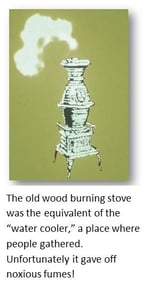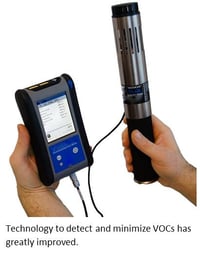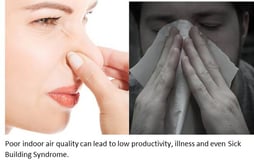When giving a talk on Indoor Air Quality (IAQ) in 1991, I was discussing one of the consequences of poor IAQ – Sick Building Syndrome. A woman raised her hand and said, “I have that.” The room went silent. She continued, “I was teaching at school and they started painting. By the time I left that first day I had tingling in my fingers. The second day I had tingling all the way up to my elbows. On the third day I went home very sick. I went to several doctors in the area who weren’t able to diagnose it – they all said it was in my head. I finally found a holistic doctor who diagnosed it as Multiple Chemical Sensitivity (MCS).”
With the proper diagnosis, she could finally start treatment. To this day she is still hyper-sensitive to the VOCs (Volatile Organic Compounds) such as the odors from fresh paint, carpet and glue found in many buildings.
VOCs. Viruses. Stale air. Mold
They spread through the air and can lead to Sick Building Syndrome. Left unchecked, they can cause serious health issues.
Sometimes the underlying source is easily seen, detected and mitigated. Sometimes exposure causes long-term health issues for those exposed.
Most often, especially in flu season or as a result of adverse events such as flooding or an epidemic like COVID 19, it pays to monitor Indoor Air Quality (IAQ).
What is the cost of poor IAQ?
The term “Indoor Air Quality” may be relatively new, but the issues have been around for a long time!
 According to pubmed.gov, “Indoor air was believed to be a major environmental factor for more than a hundred years, from the start of the hygienic revolution, around 1850, until outdoor environmental issues entered the scene and became dominant around 1960.”
According to pubmed.gov, “Indoor air was believed to be a major environmental factor for more than a hundred years, from the start of the hygienic revolution, around 1850, until outdoor environmental issues entered the scene and became dominant around 1960.”
Today we know that poor IAQ costs time and money:
- The American Lung Association says that U.S. adults missed approximately 10.1 million work days in 2013 due to asthma.
- The Centers for Disease Control & Prevention (CDC) estimates that sinus infection sufferers miss an average of four work days each year.
- Some estimates place the cost of poor IAQ to the United States' economy at $168 billion - and it definitely will be significantly higher in 2020. Part of that cost relates to direct medical care, while some of it can be traced to reduced productivity due to “presenteeism” (when people go to work or school even when they are sick) and absenteeism.
- Litigation in this area has been growing over the last decade - and it is stressful, time consuming and expensive!
It’s the ‘70s Man
The 1970s oil embargo forced everyone to conserve energy. Many buildings tightened or sealed up the building envelope. This helped lower heating and cooling costs. Unfortunately, these tight buildings, with minimal outside air (<5 cfm/sf!) created a different crisis - Sick Building Syndrome and Building Related Illness (SBS, BRI).
Over time, we in the HVAC industry, along with the scientific and academic community, have determined that there is a range of ideal cfm/SF depending on use and how many people are typically in a space. For example, an average of 15 cfm/person for an office environment is considered ideal per ASHRAE.
The State of the Art
With Building Energy Management Information Systems (BEMIS) connected to the Internet of Things (IoT), and the right training, a building manager can make even small changes that create big impact in occupant comfort.
This technology makes it much easier to monitor, and change, in real time what’s happening in your building. Even if you’re the facilities manager for a university campus spread across multiple buildings, or a large corporation with buildings in several states, you can address the classic “I’m too hot/I’m too cold” issues from your tablet or phone.
Other improvements include better tests for VOCs, an increasing number of low-VOC products, and enhanced energy recovery systems that allow more outside air to be brought into buildings at minimal cost increase.
Green Design for Tomorrow
Using these tools, we can optimize energy use while maintaining a healthy indoor environment, starting with building and energy systems design. Consider the building materials (for VOCs), energy and air management systems, proper outside air intake and flow, as well as ongoing, preventive maintenance that may include the following:
- Energy Optimization
- Proper Commissioning
- Continuous Commissioning (to make sure it’s always working as designed)
- Dedicated Outdoor Air Systems (DOAS)
- Dedicated Climate Air Systems (DCAS)
ASHRAE’s next Handbook of Fundamentals, due out in 2021, will have a chapter dedicated to Climate Change, how to think about it and how to design for it.
IAQ Pitfalls to Avoid
If you can open windows in your building, make sure the HVAC systems are not also running at the same time! Few things waste more energy than running a heating or cooling cycle when really cold, or really hot, air is being let into the building for extended periods.
Whatever you do, do not ignore an employee or tenant complaint. Whether the issue is real or perceived, the most important thing to do is respond respectfully. Then investigate.
- Identify the Problem
- Make Corrections (if necessary)
- Report Back
- Get outside help if necessary
- Educate for Future Prevention
Remember, “Perception Is Reality.” When someone does have a concern, a bit of compassion and prompt attention to the issue goes a long way toward mitigation and avoiding litigation.
If you have a question about IAQ and the potential for litigation, contact us.
Adapted from Jim Newman’s presentation on IAQ for the panel discussion "Watch Out for the Unforeseen when Designing Green," ASHRAE Winter Conference 2020, Orlando, FL




